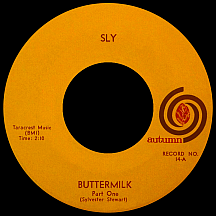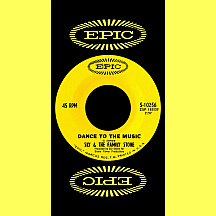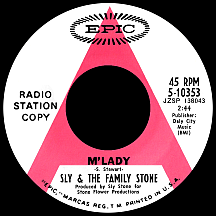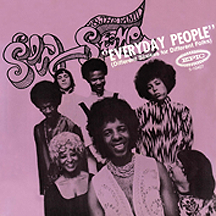SLY AND THE FAMILY STONE
Young Sylvester Stewart didn't quite gel with his schoolmates. An eccentric child, he didn't mind being different. Denton, Texas may not seem like an obvious starting point for one of the originators of funk music, but an early move to the San Francisco area provided an opportunity to bask in the experimental sounds coming from the Bay in the mid-'60s. He created the concept for Sly and the Family Stone, a performance and recording act unlike any that had come before, laying the foundation (along with a few musically adventurous others in various parts of the U.S.) of a major musical trend. During his breakout period later in the decade, journalists came up with their own names for his sound, "psychedelic soul" (an ambiguous phrase that skimmed over the depth of his stylistic influence) being the most obvious. Many steps were taken prior to his incredible success, any number of which might have detoured the path had Sly not been determined to take control of his own fate.
His entry was twofold. First, he made attempts at forming a band, learning to play piano, guitar, bass, drums and trumpet while attending high school and college in Vallejo, California. The Viscaynes counted as many as six among its ranks, Sylvester the only black member, playing three or four instruments while singing lead with three guys and two girls backing him vocally. In the fall of 1961 they appeared on channel 5's KPIX Dance Party hosted by Dick Stewart, leading to the recording of a teen ballad, "Yellow Moon," for small local label VPM, which became a modest hit late in the year on competing top 40 stations KYA and KEWB, though it failed to get airplay outside the Bay Area. Sylvester immediately released a solo single on the Luke label, "A Long Time Alone," credited to Danny (Sly) Stewart, the arrangement nearly identical to the Viscaynes disc; his vocals on these early efforts (somewhat similar to Little Anthony) are higher-pitched than anything that followed, including a third single in mid-'62 (on the one-shot G&P label), "Help Me With My Broken Heart," credited this time under his birth name.
Then the second phase began. KSAN-AM 1450 had been San Francisco's popular rhythm and blues station since the mid-'50s; in 1964 its call letters were changed to KSOL (K-Soul!) and after graduating from a broadcasting course (The Chris Borden School of Modern Radio Technique!), Sylvester snagged the 7-to-midnight slot using Sly Stone as his on-air name, fitting right in with the other jive-talking DJs and ultimately doing them one better when station management allowed him to play rock songs, especially the British Invasion hits that were all over the top 40 stations at the time, a move that increased ratings and Sly's popularity. Tom Donahue and Bob Mitchell, the KYA deejays who'd broken his first single in '61, had started Autumn Records the previous summer and hired Sly as a producer in '64 (he treated it as a sideline to the KSOL gig). As if he wasn't busy enough, Sly also put a band together called The Stoners, hired by Tom and Bob to back some of the artists that appeared in a series of concerts they hosted at the Cow Palace.
Local singer Bobby Freeman, who'd had hits on other labels as far back as 1958, was signed to Autumn and Mitchell gave Sly a shot at writing and producing a hit for him. The result was "C'mon and Swim," a song by Sly and Tom inspired by Freeman's onstage "paddling" moves; the single was a national top ten hit and the latest in a long line of '60s dance fads. Then Sly waxed his own single for Autumn, "I Just Learned How to Swim," an obvious answer to "C'mon" but with more of a garage-rock feel (then he came up with "S-W-I-M" for Freeman's follow-up before retiring the gimmick). Stone had singles of his own for Autumn in '65; "Buttermilk" and "Temptation Walk" were keyboard-based instrumentals similar to what Billy Preston was doing in Los Angeles (several months later, Sly did the arrangements for Billy's Capitol LP Wildest Organ in Town!). He was credited simply as Sly on the labels; members of the Stoners served as session players in addition to an unidentified female singer on the second track repeating two words: 'Let's walk!'
Then Sly scratched his itch to produce some rock acts, starting with The Beau Brummels, at first under the "Cougar Productions" heading before getting his own credit as producer. Hit singles ("Laugh, Laugh," "Just a Little") came immediately and he branched out, working throughout 1965 with Autumn bands The Spearmints, Chosen Few and the hitmaking Mojo Men ("Dance With Me") while helming two more solid sellers for the Brummels. His nightly KSOL shows continued without a break. "I Still Love You" by The Vejtables of San Mateo County reached the charts in October; the band's singer-songwriter Jan Ashton had a drum-playing cousin, Greg Errico, who would soon become a part of Sly's master plan.
One of the last Beau Brummels sessions (before the group signed with Warner Bros.) yielded a Stone-penned track, "Underdog," which went unreleased but would emerge again as a notable component in Sly's own career. In 1966, shortly after Autumn Records closed its doors, Sly produced San Fran band The Great Society (an early Jefferson Airplane prototype with lead singer Grace Slick); "Someone to Love" on the Northbeach label was an early version of the Airplane's breakthrough single "Somebody to Love" the following year. Around that time he also worked with The Emergency Crew on some unreleased tracks; the band moved on, changed its name to The Grateful Dead, and began a "long, strange trip" that lasted about five decades.
Sly's ambitions had rubbed off on his brother, guitarist Freddie Stewart; he'd formed a band (after Sly mentioned on-the-air that his kid brother was looking for local musicians). They were called The Stone Souls and sometimes crossed paths with the Stoners; Sly produced some demos for them. In 1967, Tom Donahue was largely responsible for changing the format of KMPX-FM 106.9 to "underground rock" as he reasoned San Francisco was ready for a harder-rocking, more experimental ("psychedelic") station. Sly Stone, still doing his nightly show on KSOL (later moving to "Lucky 13," KDIA-AM 1310, for a brief stay), was chomping at the bit to be part of the scene when he hit upon an idea that would make him stand out...but it presented a risk that might not work, considering no one else had ever done anything quite like it.
He formed a band that would share his vision: a family group (with a few non-family members) that he felt could be molded to fit the soul/rock hybrid he envisioned. Freddie came on board, eager to take Stone as his new last name. Cynthia Robinson had known Sly since high school in Vallejo; she played trumpet, an unexpected but welcome addition to the mix. Denver, Colorado-born Bay Area transplant Gerald "Jerry" Martini became the band's saxophone player and Greg Errico, who'd been friends with Sly more than a year, had honed his drum skills to a point where he was welcomed into the group.
With the five in place, long daily practice sessions consumed nearly all their time in the fall of '66. A curious lineup of two black men, a black woman and two white guys, they played their first gig at the Winchester Cathedral in Redwood City, causing a sensation yet being booked afterwards between two and five o'clock Saturday and Sunday mornings. Before they could negotiate a better slot, Columbia Records A&R reps signed them to the company's Epic label and within two months they were performing in the city at the higher-profile Fillmore, followed by a spot opening for The Animals at the Oakland Coliseum.
One more "soul brother" was added in 1967; Beaumont, Texas-born bassist Larry Graham coincidentally had a strong baritone/bass vocal sound. Then, Sly's sister Rosemary Stewart ("Rose Stone") came into play, running hot on keyboards and adding a strong voice to the act. The group's look was never uniform like so many bands in those days. They wore suits in white, black or pastel, vests and shirts with checkerboard designs, polka dots, flowery outfits evoking hippie culture, whatever wild styles appealed to each member. Sly revived "Underdog" for the first Family Stone single, a heavy-horn-based tune with an odd, minor-key "Frère Jacques" intro, the rapid-fire lyrics dealing with the fight for equality, being 'demoted' and 'underestimated.' The message was strong, the sound not particularly radio-friendly. The rest of debut album A Whole New Thing proceeded in this vein, sonically bold though lyrically more romantic; critically well-received but a failure with record buyers.
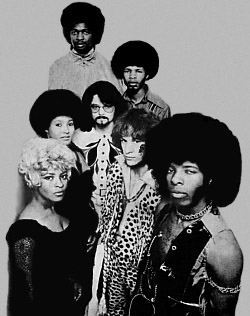
His next move was to take a common, relatable topic - in this case, dancing - and wrap it in a funky package. "Dance to the Music" was presented in layers, starting with the drummer, then guitar ('...to make it easy to move your feet...'), then bass, organ, trumpets ('Cynthia and Jerry got a message that says: all the squares, go home!') and voices ('dum-dum-dumdumdum-dum-dum...'), leading up to where the whole thing breaks loose (this approach wasn't new and had in fact been done many times; King Curtis's jazz equivalent, "Memphis Soul Stew," was a radio hit at about the same time Sly's track was coming together). The single worked its way up the charts in the early months of 1968, reaching the top ten in April. It was the latest in a groundswell of similar efforts by James Brown, George Clinton's groups Parliament and Funkadelic and others. At some point in the '70s it all fell under the heading of funk music.
With a major hit in the books, Sly's radio career fell by the wayside. He was granted more creative freedom to write and produce any type of music he deemed appropriate. The cleverly encouraging, circusy-sounding "Life" ('...you don't have to die before you live') was coupled with "M'Lady," a simple ode to womanly appeal arranged similar to "Dance." Neither was a big hit, but both were regular components of live shows. Near the end of 1968, the big one was released. "Everyday People" used a fairy tale-like melody to make a case for equality, the song's real hook being 'Different strokes for different folks,' intended to validate differences in culture (the phrase had been around for some time, mainly in the black community; Muhammad Ali frequently used it, as did singer Syl Johnson on his 1967 single "Different Strokes"). Sly's song wasn't an automatic add at top 40 radio; debuting on the Billboard charts in November 1968, it made a slow upward journey, reaching number one three months later in February 1969 and staying on top four weeks, ranking as one of the year's biggest hit singles. Its B side was popular too; "Sing a Simple Song" used used a sure-fire formula: intricate jam, simple lyrics ('talkin'...walkin'...livin'... givin'...'), its beat ideal for shakin' your rump.
The album Stand! was issued shortly afterwards, its top 30 title track a call to speak out: 'Stand! There's a cross for you to bear...Stand! For the things you know are right...Stand! You've been sitting much too long...' The Civil Rights messages came through loud and clear, particularly in those months following the assassination of Dr. Martin Luther King, Jr. Sly, never idle, produced "Life and Death in G&A" for New York City soul group Abaco Dream. Its main message? 'If it feels good, it's all right!' The single, on A&M, rode the charts for several weeks in the fall of 1969. While other acts jumped on the funk/psych bandwagon (The Temptations were quick to adapt), Sly had two more major hits in the coming months: happy love song "Hot Fun in the Summertime" in the fall and a positivity-spreading second number one, "Thank You Falettinme Be Mice Elf Agin," at the beginning of 1970, with a B side that was actually the more popular side in a handful of cities: "Everybody is a Star."
No new material emerged for several months (though the "Stand!" flip, "I Want to Take You Higher," entered the charts a year after its first go-around when a cover by Ike and Tina Turner appeared and Epic Records responded by promoting Sly's original; both versions reached the top 40, the competition preventing either, perhaps, from achieving a 'higher' level. Sly, meanwhile, was busy with Little Sister, a trio led by real-life sibling Vaetta Stewart ("Vet Stone") with Mary McCrary and Elva Mouton, all three former members of The Gospel Tones. They'd done backing vocals for the Family Stone and Sly decided to produce some tracks for them. He started a label, Stone Flower (after his already-established Stone Flower Productions), as a subsidiary of Atlantic Records. The label had only a few releases including a remake of "Life and Death in G&A" by fellow San Franciscan Joe Hicks. But the Little Sister records were hits; "You're the One," a two-part jam running nearly seven minutes (side two receiving most of the airplay), and "Somebody's Watching You" were top 40 pop and top ten R&B hits in 1970.
Another year flew by and with several weeks remaining, "Family Affair" appeared and shot quickly to number one, spending most of December '71 there. The track was a curiosity: Sly and Rose did the vocals (her part consisted of repeating the line 'It's a family affair') and Billy Preston played organ (no others were involved). Lyrics made brief commentary on differences between siblings and newlywed relations; mainly it was Sly riffin', ad-libbing 'Ow! Do-do-do, hey-hey...' The follow-up, "Runnin' Away," featured Rose's vocals (and a little bit of Sly) against a sharp, funky horn section. The two singles were included on the band's best-selling album There's a Riot Goin' On (its title an answer to the question posed on Marvin Gaye's groundbreaking 1971 single and album What's Going On). It was a mostly-solo effort, a necessary move if there was going to be an album at all, as some of the members had become disillusioned and tempers were running high. Drummer Greg had quit, while trumpeter Cynthia remained steadfast. She, Jerry and Rose (and Billy Preston) made some contributions while it was anyone's guess where the others had gone. Sly put perhaps 80 percent of the record together by himself and critics were impressed, though opinions differed on the set's low-fi sound. There are long non-vocal segments and full instrumental tracks and the overall vibe is infectious. The album spent the final two weeks of 1971 at number one. It's been said that Stevie Wonder was inspired by this LP to embark on some of his own one-man projects. And we all know how that worked out!
The entire band was on board for 1973's Fresh LP (except Errico, who was replaced by session drummer Andy Newmark), including Vet Stone and the other two members of Little Sister, who hadn't made a record of their own since 1970. "If You Want Me to Stay" was the LP's hit single. Larry Graham somehow got it into his head that Sly was trying to have him killed, so he quit for good and formed Graham Central Station. A year later, Small Talk included "Time For Livin'," the group's last single to reach the top 40. High on You was marketed in late '75 as a solo Sly Stone LP, though all five remaining members made contributions in addition to Vet and a new Little Sister lineup. Afterwards, Cynthia was about the only one who stuck around. "Family Again," the final single for Epic in 1977, is a jam but has a misleading title.
A deal was signed with Warner Bros. Records under the band's full name, though Sly was the only original member. Only one minor Soul (formerly R&B) chart hit resulted, "Remember Who You Are" in 1979. Larry Graham scored a top ten solo hit in 1980 with the ballad "One in a Million You" and continued recording and performing with Graham Central Station for many years. Sly floated around throughout the '80s, occasionally entering recording studios, most notably in 1986 when he duetted with Time guitarist Jesse Johnson, who was recording solo for A&M Records. "Crazay" is one of those rare songs where the review is contained in the title. An infectious blast of energy, it's more Sly than Jesse; the extended remix is an extra-fun seven minute diversion. Between October 1986 and February 1987, it was his last recording to take a ride on the national charts. Since then, Sly Stone has shown up in public sporadically, the highlight/low point (depending on your own perspective) a brief 2006 Grammy Awards performance of "I Want to Take You Higher." The mohawk-wearing 62-year-old abruptly left the stage around the two-minute mark.
NOTABLE SINGLES:
- Yellow Moon - 1961
by Viscaynes - A Long Time Alone - 1961
by Danny (Sly) Stewart - Help Me With My Broken Heart - 1962
by Sylvester Stewart - I Just Learned How to Swim - 1964
by Sly Stewart - Buttermilk (Part One) - 1965
by Sly - Temptation Walk (Part One) - 1965
by Sly - Underdog - 1967
- Dance to the Music - 1968
- Life /
M'Lady - 1968 - Everyday People /
Sing a Simple Song - 1969 - Stand! /
I Want to Take You Higher - 1969 - Hot Fun in the Summertime /
Fun - 1969 - Thank You Falettinme Be Mice Elf Agin /
Everybody is a Star - 1970 - Family Affair /
Luv n' Haight - 1971 - Runnin' Away - 1972
- Smilin' - 1972
- If You Want Me to Stay - 1973
- Frisky - 1973
- Time For Livin' - 1974
- Loose Booty - 1974
- I Get High on You - 1975
by Sly Stone - Family Again - 1977
- Remember Who You Are - 1979
- Crazay - 1986
by Jesse Johnson (featuring Sly Stone) - Eek-Ah-Bo-Static Automatic - 1987
by Sly Stone


